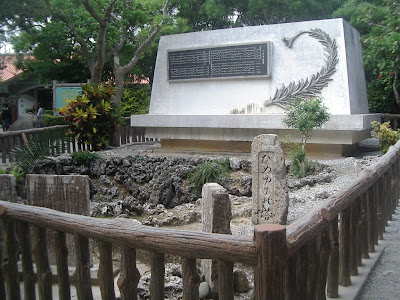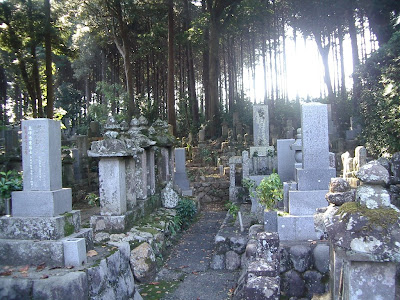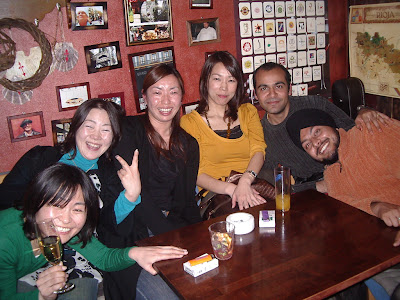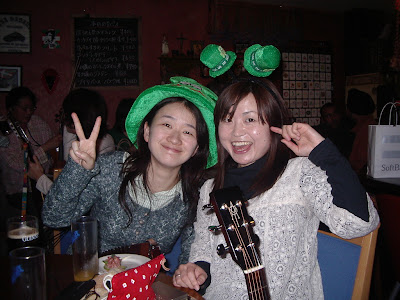Well, this is a typical Japanese school trip. Just like the first brave Japanese tourists to Europe and the USA of the early 1970s, Second-Year high school students (16-17) travel every year with fretting teachers armed with bullhorns in large groups of 150-250 to previously unknown parts of their own country in a cocoon of safety, a bubble in which nothing untoward may happen. Fair enough. They stay in fantastic hotels (no grubby old youth hostels), get charged for evening gourmet meals which they don't quite always receive, although I must say that the help-yourself-to-everything breakfasts are truly magnificent. It's a change. It's a break from classes. It's paid off in monthly installments from the time of entering the school so 180,000 Yen for 3 nights and 4 days plus airfare doesn't seem all that bad. Work it out. Just 1800 dollars or 900 quid, 1250 Euro. No bother, I suppose. Money values change, I know, but back in the days when I was travelling that would have lasted me for -- I don't know? -- three or four months?
No more. That's enough weirdy comment where little comment is needed. The pictures below tell their own stories.
One more thing: if you'd like more info on Okinawa click on the Wikipedia Link at the bottom of the post, just below the last photograph.
 1. The Inner Gateway to Shuri Castle
1. The Inner Gateway to Shuri Castle 2. The Central Courtyard
2. The Central Courtyard 3. Battle of Okinawa Memorial Park
3. Battle of Okinawa Memorial Park 4. Memorial Park
4. Memorial Park 5. Memorial Park: strange to see your own surname -- a long-lost cousin?
5. Memorial Park: strange to see your own surname -- a long-lost cousin? 6. Memorial Park: the Pacific Ocean meets the East China Sea.
6. Memorial Park: the Pacific Ocean meets the East China Sea. 7. Memorial Park: some of my homeroom students.
7. Memorial Park: some of my homeroom students. 8. Himeyuri: 1000 paper cranes as a memorial to the high school girls forced to become nurses.
8. Himeyuri: 1000 paper cranes as a memorial to the high school girls forced to become nurses. 9. Himeyuri: entrance to the underground cave hospital.
9. Himeyuri: entrance to the underground cave hospital. 10. Himeyuri: a rather bitter, disillusioned poem about getting pushed into the final battles.
10. Himeyuri: a rather bitter, disillusioned poem about getting pushed into the final battles. 11. The Chiraumi ("beautiful sea") aquarium
11. The Chiraumi ("beautiful sea") aquarium 12. Chiraumi
12. Chiraumi 13. Chiraumi
13. Chiraumi 14. Chiraumi
14. Chiraumi 15. Ryukyu Mura (Okinawan Folk Village)
15. Ryukyu Mura (Okinawan Folk Village) 16. Ryukyu Mura
16. Ryukyu Mura 17. R. Mura
17. R. Mura 18. R. Mura
18. R. Mura 19. R. Mura: Okinawan traditional dress.
19. R. Mura: Okinawan traditional dress. 20. R. Mura: water buff in charge of a "farmer".
20. R. Mura: water buff in charge of a "farmer". 21. R. Mura: the pottery centre.
21. R. Mura: the pottery centre. 22. R. Mura: the girls dress up as Okinawans.
22. R. Mura: the girls dress up as Okinawans.Wikipedia Link to Okinawa
It was a good trip. The kids enjoyed it. Me, myself, I didn't have to pay, so that's another good reason to shut the fff up. We live in different times, and that's the end of it. The pictures trump the words -- once you know what they portay. Nevertheless, if you somehow come around to the point of asking me what I think about dragging the local people who never identified with mainland Japan into the last months of the war -- and thereby killing off thousands of them -- this is probably not the place for it. Comment if you like, though.




























